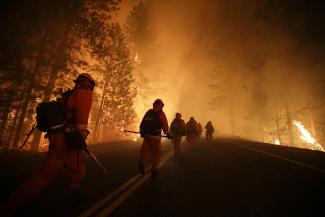Deforestation
Global trends

Almost one third of the earth’s landmass is currently covered by forests – more than four billion hectares. Just 8,000 years ago, there were 35 % more forests. Forests serve as reservoirs for drinking water and as protection against erosion, avalanches and floods. They stabilise eco systems by regulating water supply, offering a habitat for biodiversity and protecting the climate through carbon storage. Moreover, they provide forestry products such as wood or medicinal plants.
Forests only began to shrink when large portions of the human race began to settle and develop agriculture. In past centuries, Europe and Asia witnessed dramatic deforestation as huge volumes of wood were used to build fleets of ships and woodlands were cleared to make space for fields. Today, forests are disappearing from Africa, North and South America too. Only one third of Earth's forests are untouched primeval forest.
Every five years, the UN Food and Agriculture Organisation (FAO) publishes its Global Forest Resources Assessment (FRA). The edition of 2010 pointed out that tropical forests had decreased by 40 million hectares since the year 2000.
That vast loss of forests has serious consequences. Forests sustain complex eco systems that provide habitats for a multitude of plant and animal species. These delicate systems are lost if human interference tips their balance. Even little changes may result in a loss of biodiversity. That can even be the consequence of selective felling, a practice that does not clear entire areas, but only cuts down individual trees. Biodiversity is of priceless value, however, for instance in regard to medicinal plants.
Today, felling and clearance is threatening the rainforests of Southeast Asia, South America and Central Africa. Governments tend to grant exploitation permits with questionable generosity. Making matters worse, companies do not always uphold standards. All too often, there is simply no rule of law in forests.
Wood tends to be exported as a commodity. As a consequence, the countries of origin do not add value when the resource is used for manufacturing or building purposes. Private-sector interests are not limited to timber however. Some companies use cleared areas to cultivate crops – such as soy or palm oil and other monocultures – or for grazing cattle. To access the land faster, some companies resort to slash-and-burn methods. The local people generally do not benefit from the change of land use.
Reforestation is a strategy to stem the global trend. Today, secondary forests account for seven percent of the woodlands on Earth. The share is growing, as secondary forest areas in Europe, Asia and North America are expanding. China, in particular, has been planting large amounts of forests to protect its northern regions from desertification. The People’s Republic loses a lot of fertile land to deserts every year. China's “green wall” is the biggest reforestation project in the history of humankind, and Germany has supported related efforts.
Since the 1980s and 1990s, reforestation efforts have slowed down the loss of global forests. According to the FRA of 2010, the annual net loss of forested area was 13 million hectares from 2000 to 2010. In previous decades, it had been 3 million more hectares. Net loss means that reforested areas are factored in to compensate for deforested areas. In truth, deforestation affects more than 13 million hectares.
Reforestation does not replace lost primeval forests, as environmental organisations such as the World Wide Fund for Nature point out. New forests are usually monocultures. Most of them are in moderate climate zones with relatively low biodiversity. While secondary forests are no real substitute for primary ones, they do reduce the pressure that the timber business puts on rainforests. Indeed, secondary forests provide some commodities otherwise taken from rainforests. However, they offer little protection against the selective felling of rare exotic woods like mahogany in virgin forests.
Climate change is closely linked to deforestation. WWF experts estimate that about 15 % of the greenhouse gases that are emitted by humanity result from deforestation. In a vicious cycle, these gases cause global warming which is speeding up deforestation. In North America, for instance, dryness is making forest fires more frequent and more devastating. They even endanger nature reserves such as, quite recently, Yosemite National Park.
Internationally, only four percent of forest fires are started by lightning or other natural phenomena. In most cases, human beings cause the blazes, either on purpose or by accident. In Southeast Asia, for instance, slash-and-burn practices are almost always the reason. In Indonesia, in particular, huge forests have been destroyed this way.
Better protection
Forests need a stronger lobby. International agreements, such as the UN Convention on Biodiversity or the Convention on International Trade in Endangered Species of Wild Fauna and Flora (CITES) have to be enforced more vigorously. In practice, the provisions to protect forests and species are only slowly being implemented into national law. Only 13 % of the world's forests are currently protected as national parks or nature reserves. The WWF emphasises that the quality and implementation of these provisions differ greatly from country to country. In some cases, nature reserves only exist on paper.
In April 2001, the UN Forest Forum (UNFF) adopted an agreement to protect forests worldwide. It is not legally binding, but it did spell out four goals to achieve by 2015. They are
- to contain worldwide deforestation through sustainable forest management,
- to ameliorate the way forests are exploited in economic, social and environmental terms,
- to expand forest reserves, and
- to prevent cuts in the official development assistance that relates to forest protection.
The FAO's next FRA will show to what extent these and related goals are achieved.
Forests and trees have another important quality. They regrow, so they are renewable. Forestry scholars Jürgen Blaser and Hans Gregersen expect humankind to make more use of this feature in the future. There is no way around the fact that forests are an environmentally friendly alternative to limited fossil fuels, they say.
The two researchers expect the uncontrolled destruction of rainforests to continue over the next 50 years, because of climate change and the demand for wood and raw materials found in virgin forests. The trend could be stopped, however, if forest protection was enforced rigorously today. Blaser and Gregersen argue that the world's forests could then regenerate over the next 300 years.
Monika Hellstern studies political science and is a free-lance author.
euz.editor@dandc.eu














